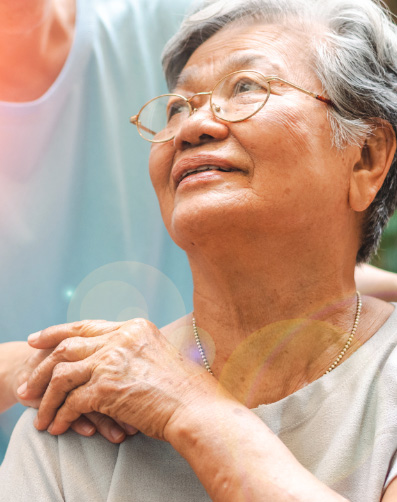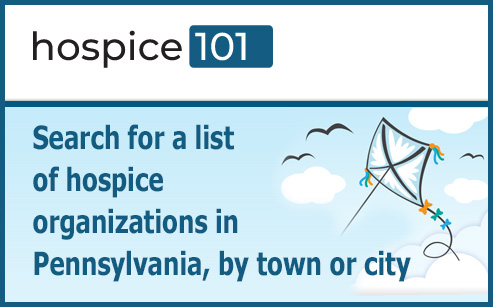
Feature story (Dec. 2023 edition)
By Nancy O'neill
11/20/2023

Hospice is also described by what it is not. “Hospice is not euthanasia; it is not assisted suicide,” Karen, who works within the Diocese of Erie as a hospice chaplain, emphasizes. “Hospice is frequently misunderstood because people avoid talking about death. People should talk about it, because it’s just a part of life; death is a natural process that we strive to make as painless and comfortable as we can.” Hospice is also recognized by the Catholic Church as a way to come to terms with the end of life, says Father Dennis Martin, a chaplain at AHN/St. Vincent Hospital. “Death is the gateway to heaven,” he emphasizes. “Eternity begins when we leave this dimension.”
Hospice is also recognized by the Catholic Church as a way to come to terms with the end of life, says Father Dennis Martin, a chaplain at AHN/St. Vincent Hospital. “Death is the gateway to heaven,” he emphasizes. “Eternity begins when we leave this dimension.”
Hospice is also a time for open conversation, which can be very healing for the patient and the family, says Father Dennis. “I remember one man in hospice who prepared his own funeral service — what readings and music he wanted. It was a beautiful moment.”
Hospice eligibility and benefits
Hospice is available to anyone if two physicians certify that the person will not likely survive more than six months, explains Dr. Christopher Strzalka, a board-certified palliative care physician.
“Some people may have less time; others might stay in hospice for two to three years, even longer” adds Karen. This end-of-life care is delivered at no cost to patients, as it is covered by Medicare, Medicaid and virtually all private insurance companies.
Hospice care can be provided in a dying person’s home or in a facility such as a nursing home or a freestanding hospice center, if one is available. One such facility, to be called Julia House, could be under construction by the end of the year in McKean. Such facilities exist in Meadville and Warren, and one is being built in Chautauqua County, New York. However, the Medicare Hospice Benefit only pays for medical care and does not pay for room and board at a nursing home or hospice home.
Medication and supplies are provided to patients. A nurse care manager oversees the care delivered to each patient. Other hospice staff include social service and spiritual team members who visit if requested. Hospice volunteers can also be called upon to visit patients.
The main purpose of most medications is to relieve pain and other symptoms such as depression, explains Dr. Strzalka. “As a heart surgeon for 16 years, I saw many complicated cases and many patients who were suffering from disease as well as treatment. We didn’t have the experts then to navigate these complexities such as pain relief. So, I saw an opportunity to take my expertise in another direction and completed a fellowship in Hospice and Palliative Medicine at the Cleveland Clinic. Palliative medicine is an evidence-based specialty designed to alleviate distressing symptoms. It is most appropriate for patients with chronic illnesses who are not at the end of their lives. Hospice is a type of palliative care but not all palliative care is hospice. Hospice or end-of-life care focuses on enhancing quality of life and comfort, not extending life at any cost,” he says.
Julia House represents an enhancement of hospice care, Dr. Strzalka and his wife Julia believe, as no freestanding hospice facility exists in Erie County. Julia House will initially offer nine patient rooms for 24/7 end-of-life care in a home-like environment.
It is named after Julia Strzalka, who has worked as a teacher and school principal, says her husband. “The same kind of empathy and compassion used to educate children is needed to care for patients at the end of their lives. My wife has those qualities. So the name Julia House was a natural fit," he says. More information on Julia House is available at juliahpc.com.
Caring for care-givers
Taking 24/7 care of a terminally ill loved one can be exhausting and overwhelming, says Karen. “Hospice benefits care-givers, too.” Mental, spiritual and respite support for families includes up to 13 months of bereavement services such as grief support groups.
“Some may need us right away following their loved one’s passing,” she explains. “While others don’t grieve for a while and then the floodgates open.”
When to consider hospice
Former President Jimmy Carter * exemplifies when hospice should be chosen, says Karen Moski, a counselor and executive director of Hospice of Metropolitan Erie (HOME). It should begin months before the end of life, she says. If hospice is requested just a week or two before a patient passes, services cannot help, and patients may have suffered needlessly for months or even years. “If you don’t have pain taken care of, nothing else really matters,” she explains. “You can’t sleep, you can’t think, you can’t have any sense of control over your care.” HOME was founded in 1980 as the very first hospice organization in northwestern Pennsylvania, she says, followed soon after by one in Warren. Patients and their families can choose any hospice organization, whether it’s connected to another health care provider or operated as an independent nonprofit, such as HOME.
“If you don’t have pain taken care of, nothing else really matters,” she explains. “You can’t sleep, you can’t think, you can’t have any sense of control over your care.” HOME was founded in 1980 as the very first hospice organization in northwestern Pennsylvania, she says, followed soon after by one in Warren. Patients and their families can choose any hospice organization, whether it’s connected to another health care provider or operated as an independent nonprofit, such as HOME.
“People also want to die with dignity and respect,” adds Father Dennis. “And that’s hard to have if you’re in pain. Hospice can keep you comfortable and out of pain.”
Erma Schuster of Harborcreek chose hospice for her mother-in-law and her mother. She had previously worked as a licensed practical nurse for HOME and she knew the benefits that patients and their families receive.“
The dying experience can be without pain,” she says, recalling when an adult daughter climbed into bed with her mother, and they talked and laughed for a long while. “The mother seemed to have a lot to tell her daughter,” says Erma. “She died peacefully an hour later.”
Erma remembered other hospice patients with breathing problems who were helped immensely by medications and oxygen, which are also supplied by HOME.
“These patients were able to do certain things they would not have been able to do without symptom relief. One guy was able to go out and have a beer with his buddies.”
Hospice services for Erma’s mother-in-law included not only pain relief, but nurse aides who gave baths. And the family was given a hospital-type bed. “All supplies are included,” Erma says, “for pain, for wound care, breathing problems and other symptoms of an illness. There are no deductibles or co-pays.”
Hospice can provide spiritual support, too, she adds. “And social workers explain the dying process to the families, so they realize that if their loved one won’t eat, they aren’t suffering from hunger either.” The hardest part is for the families to let go, Erma says. “Everyone says they loved it. It was so helpful.”
“For me, it was so gratifying when someone passed on peacefully. Often, they were smiling and seemed happy.”
“Hospice can be so rewarding,” says Father Dennis. “It is a blessing to us, to be with the person who is dying. Death is the final healing; there’s no more pain or suffering.”
Erma’s mother, Margaret Jackson, held her great-grandchild Elora, shortly after she returned home to enter hospice care. “My mother was able to die in her own home, thanks to hospice,” Erma says. “She was so proud of having a home since she had lived through the Great Depression. She didn’t want to go back to the nursing home.”
*Former President Jimmy Carter entered hospice care in February of this year. As of this publication (November, 2023), he has been in hospice for nine months. 
-
